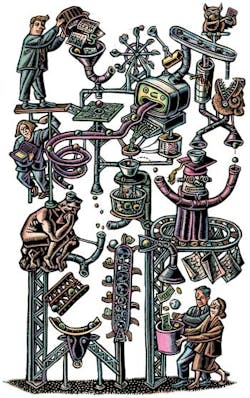Ultimately, the goal of innovation is to effect positive change that leads to better products, more satisfied consumers and increased productivity, all of which are fundamental sources of economic growth.
Innovation inherently involves risk, both for those companies that embrace it and for those that ignore it. A key challenge for companies involves maintaining the right balance of research and development (R&D) expenditures vs. income. Not enough R&D and you risk inhibiting the innovation process; too much R&D, and you risk eroding shareholder return.
After years of focusing primarily on cost control and outsourcing, there has been a noticeable shift toward introducing new and innovative products and services to enable companies to regain market share that has been eroded or outright lost due to product lines that have been left behind by a continuously evolving market. Many companies have come to realize that they can’t cost cut and outsource their way to great brand recognition and competitive superiority. They now understand that they can only survive through continuous innovation. This means developing new products that capture the imagination of the market and introducing creative, game-changing new technologies and processes that engage and delight people as well as solve real social and human needs.
Invention is usually the initial occurrence or creative instance of an idea for a new product or process, while innovation can often involve finding new and novel ways to use the invention. Hence the notion of innovation being a new way of doing things. In order to be patentable, an invention must be novel, have utility and be non-obvious. To be called an invention, an idea only needs to be proven as workable. But to be called an innovation, it must also be replicable at an economical cost, and must satisfy a specific need. This explains why not all inventions lead to innovations; not all are economically feasible.
Innovation is putting the idea into actual practice. This generally requires a structured and managed approach to move the best ideas into the market economy. Ideation and the inventions that result from the creative process are the initial, albeit essential, stages of a larger and more comprehensive innovation process. True innovation occurs when someone actually implements an invention or idea to bring change to a business, an economy, or what people use and how they conduct their lives.
Instances of invention followed by innovation have occurred throughout the history of industrialization and technology. James Watt invented the steam engine, but the innovation that followed was the steam locomotive that forever changed transportation. Thomas Edison is credited with the invention of the light bulb, but the 1879 debut of his incandescent bulb was actually preceded by other inventors. What he and his team accomplished was the invention and development of the first electric power grids that could actually use light bulbs, the founding of Con Edison and General Electric, and the electrification and illumination of entire cities. This took funding and the support of investors who believed in his vision. That was good business; that was innovation.
Herding cats?
“Managing innovation” sounds like the ultimate oxymoron. Many hardheaded business people consider the creative chaos of ideation, invention and innovation as unpredictable and random as snowflakes, and as unmanageable as herding cats. However, the world’s most innovative companies, from Procter & Gamble, 3M, Apple Computer, Toyota Motor, Southwest Airlines and Google, to Edison’s own General Electric, have not only learned how to manage innovation, they have each established a culture of innovation, where innovation has become a repeatable and sustainable process for the products they bring to market and the customer experience they provide.
Dick Slansky, [email protected], is a Senior Analyst at ARC Advisory Group Inc., in Dedham, Mass.
Subscribe to Automation World's RSS Feeds for Columns & Departments
About the Author

Leaders relevant to this article:
